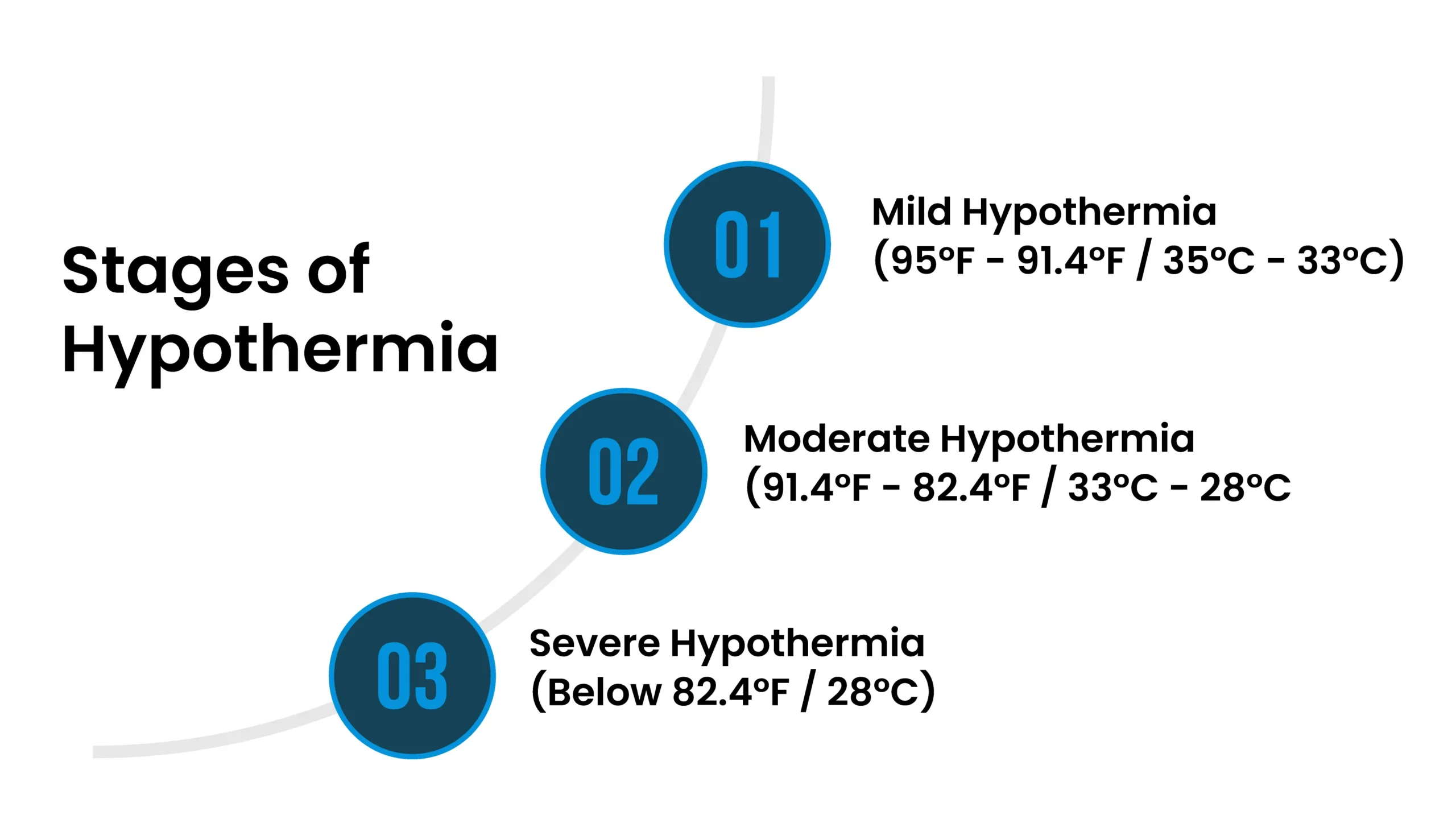

Shivering hands, chattering teeth, and the desperate hunt for another blanket – we’ve all experienced feeling cold. But what happens when that chill goes beyond mere discomfort?
When a low body temperature starts to raise questions about your health, it’s time to investigate what those numbers on the thermometer really mean. Could it be something as serious as hypothermia? Keep reading to find out.
Hypothermia is a dangerous medical condition that occurs when your body loses heat faster than it can produce it. Our normal body temperature rests around 98.6°F (37°C). When exposed to severe cold, overexertion in cold weather, or submersion in cold water, that internal temperature starts to drop. If it falls below 95°F (35°C), this signals the onset of hypothermia.
Hypothermia develops gradually, with the severity of symptoms increasing as one’s body temperature drops further. Understanding these stages is important for recognizing the danger and taking action.

Stage 1: Mild Hypothermia (95°F – 91.4°F / 35°C – 33°C)
Stage 2: Moderate Hypothermia (91.4°F – 82.4°F / 33°C – 28°C)
Stage 3: Severe Hypothermia (Below 82.4°F / 28°C)
Your body’s temperature is a vital sign, and significant deviations from the normal range can signal underlying health issues. Let’s look at the typical symptoms associated with both high and low temperatures.
Symptoms of a High Temperature (Fever)
Symptoms of Low Temperature (Hypothermia)
While infections typically cause a fever (high temperature), there’s one severe condition where low body temperature can be a dangerous symptom.
Sepsis is a life-threatening complication of an already existing infection. When your immune system overreacts to an infection, it can trigger body-wide inflammation and organ damage. One of the potential symptoms of sepsis is a drop in body temperature (hypothermia).
The average normal body temperature is generally accepted as 98.6°F (37°C). However, it’s important to understand that this is just an average, and there is actually a range of what’s considered “normal”:
Body temperature can fluctuate throughout the day, typically falling within the range of 97°F (36.1°C) to 99°F (37.2°C).
No, 36.6 degrees Celsius is not a fever. In fact, it’s considered a normal body temperature. If we go for the conversion 36.6 degrees Celsius is equivalent to 97.88 degrees Fahrenheit, which falls comfortably within the normal range.
Your forehead temperature reflects the temperature of your skin, which is naturally cooler than your internal core temperature. The temperature across your body isn’t entirely uniform. Internal, or “core” temperature, is generally higher than surface-level temperatures, like your forehead.
Forehead thermometers use infrared technology to measure the heat radiating from your skin. They are convenient but can be slightly less accurate than methods that measure your core temperature directly.
Forehead temperatures often read about 0.5°F (0.3°C) to 1°F (0.6°C) lower than oral temperatures.
Prolonged exposure to cold temperatures, submersion in cold water, or inadequate clothing in cold weather can overwhelm the body’s ability to regulate temperature.
Urine is stored in your bladder at your internal body temperature (around 98.6°F or 37°C). However, when it leaves your body, it quickly begins cooling due to exposure to the air. This is why urine typically feels cooler than your body temperature when you urinate.
When you’re dehydrated, your body tries to conserve fluids, leading to concentrated urine that may feel slightly warmer than usual. Conversely, well-hydrated urine will generally feel cooler, as it’s composed of excess water being expelled.
There is no single definitive answer to the question of the lowest survivable body temperature in Celsius. A brief exposure to extreme cold is much different from prolonged exposure. Age, health status, body composition, and even mental state play a role in how long someone can endure a cold.
However, according to records documented the the lowest survived body temperature is 13.7°C (56.7°F) in the case of a woman who nearly drowned in cold water. However, this is an extreme outlier with very specific circumstances.
Your body temperature is an important indicator of overall health. Don’t dismiss persistent readings outside the normal range, particularly if you’re experiencing other concerning symptoms. Prolonged exposure to cold can lead to hypothermia, a dangerous condition – familiarize yourself with the symptoms and seek urgent medical care if severe.
If you have questions about low body temperature, speak to your doctor to rule out any underlying medical causes. Remember, listen to the signals your body sends: shivering, clumsiness, and confusion are often signs that it needs help staying warm. Take preventative measures, especially in cold weather, to avoid potential problems.
Talk to an Expert Now